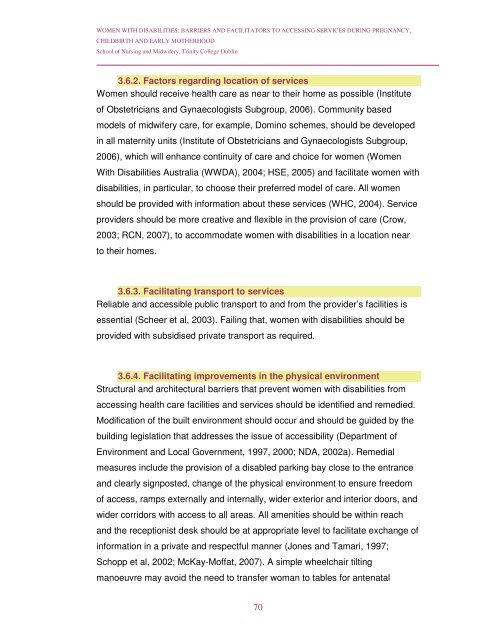Women with Disabilities: Barriers and Facilitators to Accessing ...
Women with Disabilities: Barriers and Facilitators to Accessing ...
Women with Disabilities: Barriers and Facilitators to Accessing ...
Create successful ePaper yourself
Turn your PDF publications into a flip-book with our unique Google optimized e-Paper software.
WOMEN WITH DISABILITIES: BARRIERS AND FACILITATORS TO ACCESSING SERVICES DURING PREGNANCY,CHILDBIRTH AND EARLY MOTHERHOODSchool of Nursing <strong>and</strong> Midwifery, Trinity College Dublin3.6.2. Fac<strong>to</strong>rs regarding location of services<strong>Women</strong> should receive health care as near <strong>to</strong> their home as possible (Instituteof Obstetricians <strong>and</strong> Gynaecologists Subgroup, 2006). Community basedmodels of midwifery care, for example, Domino schemes, should be developedin all maternity units (Institute of Obstetricians <strong>and</strong> Gynaecologists Subgroup,2006), which will enhance continuity of care <strong>and</strong> choice for women (<strong>Women</strong>With <strong>Disabilities</strong> Australia (WWDA), 2004; HSE, 2005) <strong>and</strong> facilitate women <strong>with</strong>disabilities, in particular, <strong>to</strong> choose their preferred model of care. All womenshould be provided <strong>with</strong> information about these services (WHC, 2004). Serviceproviders should be more creative <strong>and</strong> flexible in the provision of care (Crow,2003; RCN, 2007), <strong>to</strong> accommodate women <strong>with</strong> disabilities in a location near<strong>to</strong> their homes.3.6.3. Facilitating transport <strong>to</strong> servicesReliable <strong>and</strong> accessible public transport <strong>to</strong> <strong>and</strong> from the provider’s facilities isessential (Scheer et al, 2003). Failing that, women <strong>with</strong> disabilities should beprovided <strong>with</strong> subsidised private transport as required.3.6.4. Facilitating improvements in the physical environmentStructural <strong>and</strong> architectural barriers that prevent women <strong>with</strong> disabilities fromaccessing health care facilities <strong>and</strong> services should be identified <strong>and</strong> remedied.Modification of the built environment should occur <strong>and</strong> should be guided by thebuilding legislation that addresses the issue of accessibility (Department ofEnvironment <strong>and</strong> Local Government, 1997, 2000; NDA, 2002a). Remedialmeasures include the provision of a disabled parking bay close <strong>to</strong> the entrance<strong>and</strong> clearly signposted, change of the physical environment <strong>to</strong> ensure freedomof access, ramps externally <strong>and</strong> internally, wider exterior <strong>and</strong> interior doors, <strong>and</strong>wider corridors <strong>with</strong> access <strong>to</strong> all areas. All amenities should be <strong>with</strong>in reach<strong>and</strong> the receptionist desk should be at appropriate level <strong>to</strong> facilitate exchange ofinformation in a private <strong>and</strong> respectful manner (Jones <strong>and</strong> Tamari, 1997;Schopp et al, 2002; McKay-Moffat, 2007). A simple wheelchair tiltingmanoeuvre may avoid the need <strong>to</strong> transfer woman <strong>to</strong> tables for antenatal70
















